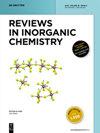生物多功能金属/金属氧化物纳米粒子的制造和应用综述
IF 3.1
3区 化学
Q1 CHEMISTRY, INORGANIC & NUCLEAR
引用次数: 0
摘要
对动物、植物和微生物进行绿色合成的重新评估为金属纳米粒子(MNPs)的制造带来了革命性的变化。与化学合成的 MNPs 相比,绿色合成具有更强的生物相容性,使其成为多种生物应用的理想选择,尤其是在生物医学领域。人们对各种生物进行了广泛的绿色合成研究。有趣的是,被子植物、藻类以及甲壳素和蚕丝等动物来源的生物材料在合成这些纳米粒子方面发挥了重要作用。此外,细菌、病毒和真菌也是还原剂的来源,从而进一步扩大了绿色合成的可能性。尽管取得了进展,但对天然还原剂的研究仍然相对有限,只有茶叶和楝树等少数例外受到关注。绿色合成的纳米粒子在各个领域都有不同的应用。在生物医学领域,由于其生物相容性更强,可用于药物输送、靶向治疗和生物成像。一些 MNPs 还具有强大的抗菌特性,有助于疾病控制和环保消毒。此外,绿色纳米粒子还能净化水质,为环境修复做出贡献,并可作为灵敏的生物传感器用于诊断和环境监测。本综述将介绍纳米粒子绿色合成(GS)领域的最新进展和进步。它还将分析绿色合成的主要特点,并评估绿色合成与化学合成相比的优缺点。本文章由计算机程序翻译,如有差异,请以英文原文为准。
A comprehensive overview of fabrication of biogenic multifunctional metal/metal oxide nanoparticles and applications
The re-evaluation of animals, plants, and microorganisms for green synthesis has revolutionized the fabrication of metallic nanoparticles (MNPs). Green synthesis provides more biocompatibility compared to chemically synthesized MNPs, which make them ideal for diverse biological applications, especially in biomedicine. Various organisms have been extensively studied for green synthesis. Interestingly, angiosperms, algae, and animal-derived biomaterials like chitin and silk have shown a prominent role in synthesizing these nanoparticles. Moreover, bacteria, viruses, and fungi serve as sources of reducing agents, further expanding green synthesis possibilities. Despite progress, research on natural reducing agents remains relatively limited, with only a few exceptions such as tea and neem plants receiving attention. Green-synthesized nanoparticles have diverse applications in various fields. In biomedicine, they enable drug delivery, targeted therapies, and bio-imaging due to their enhanced biocompatibility. Some MNPs also exhibit potent antimicrobial properties, aiding in disease control and eco-friendly disinfection. Furthermore, green nanoparticles contribute to environmental remediation by purifying water and serve as sensitive biosensors for diagnostics and environmental monitoring. This review will provide the recent progress and advancements in the field of green synthesis (GS) of nanoparticles. It will also analyze the key characteristics and evaluate the advantages and disadvantages of GS compared to chemical synthesis.
求助全文
通过发布文献求助,成功后即可免费获取论文全文。
去求助
来源期刊

Reviews in Inorganic Chemistry
化学-分析化学
CiteScore
7.30
自引率
4.90%
发文量
20
审稿时长
1 months
期刊介绍:
Reviews in Inorganic Chemistry (REVIC) is a quarterly, peer-reviewed journal that focuses on developments in inorganic chemistry. Technical reviews offer detailed synthesis protocols, reviews of methodology and descriptions of apparatus. Topics are treated from a synthetic, theoretical, or analytical perspective. The editors and the publisher are committed to high quality standards and rapid handling of the review and publication process. The journal publishes all aspects of solid-state, molecular and surface chemistry. Topics may be treated from a synthetic, theoretical, or analytical perspective. The editors and the publisher are commited to high quality standards and rapid handling of the review and publication process.
Topics:
-Main group chemistry-
Transition metal chemistry-
Coordination chemistry-
Organometallic chemistry-
Catalysis-
Bioinorganic chemistry-
Supramolecular chemistry-
Ionic liquids
 求助内容:
求助内容: 应助结果提醒方式:
应助结果提醒方式:


